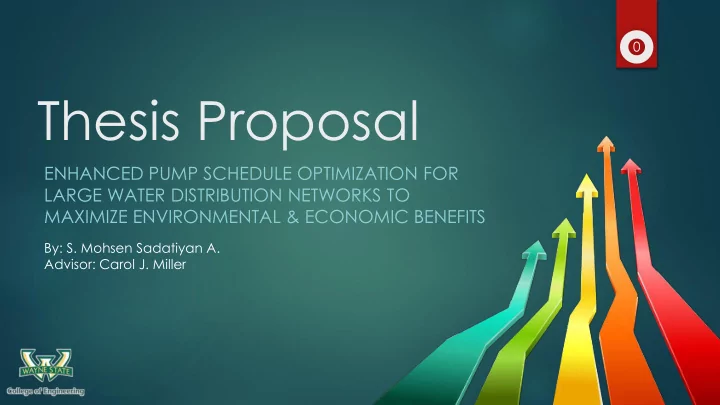

0 Thesis Proposal ENHANCED PUMP SCHEDULE OPTIMIZATION FOR LARGE WATER DISTRIBUTION NETWORKS TO MAXIMIZE ENVIRONMENTAL & ECONOMIC BENEFITS By: S. Mohsen Sadatiyan A. Advisor: Carol J. Miller
Outline 1 What is it and Why is it worth studying Slides & 2 3 Slides to 4 8 Background of the Subject Research gaps Slide 9 Our proposal for further studies Slides to 10 19
Need for Optimizing Pump 2 Operation Relative Energy Consumption in Water Treatment EWRI. (2014). In-plant 2% of U.S. electricity used for Public water water Water & wastewater services pumping treatment Raw water 8% 14% puming More than 50% increase in energy 11% consumption by 2050 Electricity Bill: ¾ of the operating costs of municipal water facilities optimizing pump operation can result in 10% reduction of the annual energy Finished water related costs pumping 67 67%
What Do We Mean By “Optimization” 3 Satisfying required pressure and flow demand
Optimization Objectives 4 Calculating Flow, Pressure, Tank Reporting Level, energy final Pump Usage, etc. Schedule Creating The Evaluate Generating a Initial Pump &Compare New Pump Schedule Results Schedule Calculating Pollutant Emission
Optimal Pumping Schedule change in change in pollution emission energy cost by meet system by time time requirements with different shift energy set of shift pump demand (time & operation operation (time & space) schedules space) reduce pollutant reduce total optimal pump emission schedule pumping cost minimum energy demand, cost & associated pollutant emissions
PEPSO V 1.0 Development PEPSO: Pollutant Emission & Pump Station Optimization 2 drinking water systems within the Great Lakes watershed Quasi- Newton Binary Method Multi- Objective & POP Modified Real number Visual Initial Pump Crossover & interface Feasible Optimizatio Mutation solution n Program Variable Genetic (2008) (2013) speed Algorithm pump PEPSO V0.1~0.3 PEPSO V0.4~0.4.5 PEPSO V0.8~0.8.0.3
User Interface & Options of PEPSO V1.0 • Electricity cost pattern • Pollutant selection • Power grid data • GA parameters • Objective function weights
Outputs of PEPSO V1.0 • Pump schedule • Optimization trends • Pressure control results • Detailed output report
PEPSO V1.0 Outputs Optimum pump schedule
PEPSO V1.0 Outputs Optimum pump schedule
PEPSO V1.0 Outputs Objective Function Minimization
PEPSO V1.0 Outputs Junction Pressure Constraints
PEPSO Empowered by LEEM
Research Gap 7 Spatial & Temporal variability of pollutant emission Optimizing large WDS Considering practical usage of the output of optimization process Using metamodel-embedded evolution framework Helping user to select the optimum result among solutions of Pareto front
Need to Improve Supporting complicated electricity tariffs for each pump Better tank level control Better pump switches control Take into account power demand cost More user friendly environment Getting real time environmental data from LEEM server
Market Needs Simpler optimizer Default optimization options and one click optimization Faster optimizer Considering effect of control valves (e.g. throttling valves) Considering all system constraints Water quality issue and stored water circulation Maintaining required level of stored water in tanks Considering minimum speed of each VFD Considering size and age of pumps
Entering Market Challenges Up-to-date, accurate and calibrated hydraulic model Reliable water demand prediction or historic data Accessing to SCADA system for real-time optimization Unfamiliarity of operators with hydraulic models and design or optimization software Lack of accurate information about pumps efficiency System capability for optimization (e.g. enough elevated storage) Other type of energy waste that aren’t directly related to pump schedule (e.g. head loss at tank inlet, inefficient pump sizing, unnecessary pressure demand)
Better LEEM More area coverage More sensitive and accurate marginal generator finder More accurate pollutant emission calculation More pollutant More reliable & clear data providing format
Research Hypothesis 8 It is possible to develop a pump operation optimization tool that decreases both energy usage and related pollutant emissions for real WDSs within a reasonable time and generate practical pump schedule
Methodology 9 Preparing test cases • Optimizer • Testing algorithm • Comparing & • WDSs models • Hydraulic analyzing results • Best known simulator solutions and real data Testing and Programing analyzing result
Developing the Optimization Tool 10 Complicated Tariff Live Calculation Replacing Connection GA with to LEEM NSGA II Embedding ANN Local Search & PEPSO V2 Restructuring PEPSO V1 Polishing Near to Modular Optimum Result Design Tank Level Constraints Pump Live Operation Optimization Constraints Parameter Adjustment
Research Plan for PEPSO V2.0 14 Phase I Phase II Phase III Preparing Metamodel Creator Tool Adding Developing Constraints and Analyzing and Optimizer Tool Heuristics to Comparing Optimization Results Algorithm Connecting Testing Optimizer to Optimization LEEM Designing and Tools Preparing Preparing Test Multiobjective Cases Optimization Code
Next PEPSO (PEPSO V2.0) More efficient Engineering heuristic Faster hydraulic simulator More aware about pump conditions & system constraints More user friendly Simpler & graphical interface Easier project saving, running & storing options (research & market) Easier connection to LEEM
15
Recommend
More recommend